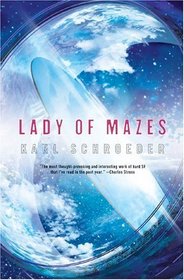Helpful Score: 1
This one was complex, and because of that, I had to re-read it. Lady of Mazes asks the question, "How do you give meaning to human existence, when everything can be easily generated or simulated?" And this is in the context of ubiquitous nanotech, utility fogs and virtual reality (inscape). That's just the big picture of the book.
On the smaller level, its about Livia Kodaly who lives in Teven Coronal (another name for a Bishop Ring - 1000 km radius, 500 km across, with a surface area of roughly one fifth of the habitable area of Earth) in a society called Westerhaven, one of the more open and cosmopolitan on this habitat. And there are lots of them - neo-primitvists of Raven, sky dwelling Cirrus, ocean dwelling Oceanus and on and on. These civilizations exist one on top of another separated by inscape illusions, and 'tech locks.' Tech locks allow people who have chosen certain values to have access to only technology that reinforces those values (for Schroeder's purposes this also includes senses and body plans). So, the very technological Westerhaven can't conquer (or overwhelm) the people of Raven because they can only interact with them through shared values and common technologies. These mixes of societies, values, tech locks and inscape are called Manifolds.
In the hands of many authors, the coronal and manifolds would be the basis for a novel by themselves. To Schroeder's credit, he moves beyond it. To a setting that has wars with multi-billion casualties as historical footnotes, open source government, ubiquitous inscape and AI.
It opens with a very brief overview of everyday life in Westerhaven from the viewpoint of Livia Kodaly, then leaps to two other manifolds, the Drummers and Raven's People. There we meet Quingi, a diplomat of Raven's People. They have something very big happening - the return of the ancestors. Livia and another Westerhaven native witness this, and realize something is very, very wrong because the tech locks no longer work.
This shortly leads to an invasion of Westerhaven and the collapse of many manifolds, and Livia's flight (along with a selection of others) to different manifolds, with their own traps and flaws.
I'm trying not to give too much away, but from their it gets complex and interesting looking at the wider world beyond the Teven Coronal and its complexities and limitations. And this is where the question in the firs paragraph comes in.
I highly recommend this book to fans of SF that like to think and ponder the implications of technologies.
On the smaller level, its about Livia Kodaly who lives in Teven Coronal (another name for a Bishop Ring - 1000 km radius, 500 km across, with a surface area of roughly one fifth of the habitable area of Earth) in a society called Westerhaven, one of the more open and cosmopolitan on this habitat. And there are lots of them - neo-primitvists of Raven, sky dwelling Cirrus, ocean dwelling Oceanus and on and on. These civilizations exist one on top of another separated by inscape illusions, and 'tech locks.' Tech locks allow people who have chosen certain values to have access to only technology that reinforces those values (for Schroeder's purposes this also includes senses and body plans). So, the very technological Westerhaven can't conquer (or overwhelm) the people of Raven because they can only interact with them through shared values and common technologies. These mixes of societies, values, tech locks and inscape are called Manifolds.
In the hands of many authors, the coronal and manifolds would be the basis for a novel by themselves. To Schroeder's credit, he moves beyond it. To a setting that has wars with multi-billion casualties as historical footnotes, open source government, ubiquitous inscape and AI.
It opens with a very brief overview of everyday life in Westerhaven from the viewpoint of Livia Kodaly, then leaps to two other manifolds, the Drummers and Raven's People. There we meet Quingi, a diplomat of Raven's People. They have something very big happening - the return of the ancestors. Livia and another Westerhaven native witness this, and realize something is very, very wrong because the tech locks no longer work.
This shortly leads to an invasion of Westerhaven and the collapse of many manifolds, and Livia's flight (along with a selection of others) to different manifolds, with their own traps and flaws.
I'm trying not to give too much away, but from their it gets complex and interesting looking at the wider world beyond the Teven Coronal and its complexities and limitations. And this is where the question in the firs paragraph comes in.
I highly recommend this book to fans of SF that like to think and ponder the implications of technologies.




